

Kremlin
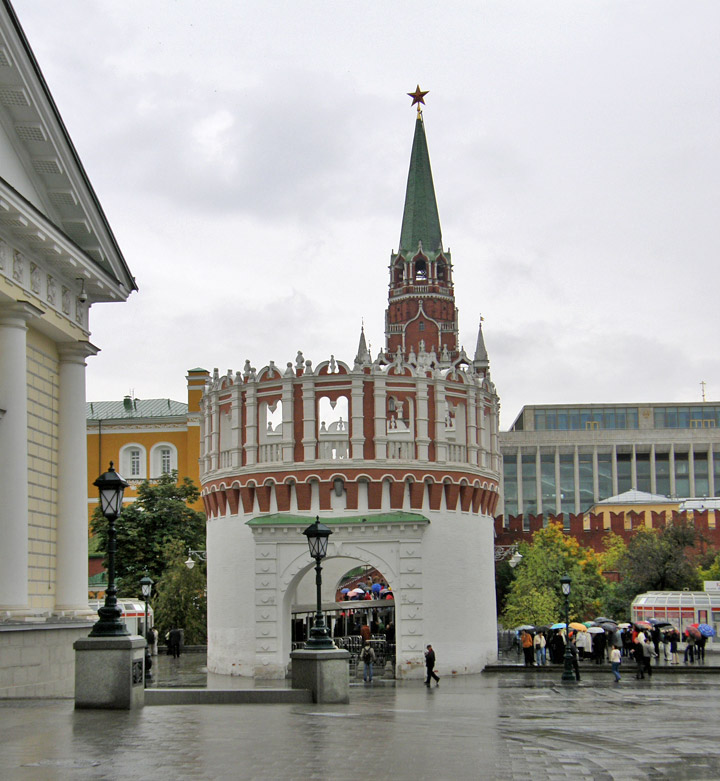
Kutafya Tower
The Moscow Kremlin (Russian: Московский Кремль) is a historic fortified complex at the very heart of Moscow, overlooking the Moskva River (to the south), Saint Basil's Cathedral (often mistaken as the Kremlin) and Red Square (to the east) and the Alexander Garden (to the west). It is the best known of kremlins (Russian citadels) and includes four palaces, four cathedrals, and the enclosing Kremlin Wall with Kremlin towers. The complex serves as the official residence of the President of Russia.

Trinity Gate Tower
The site has been continuously inhabited since the 2nd millennium BC, and originates from a Vyatich fortified structure on Borovitsky Hill where the Neglinnaya River flowed into the Moskva River. The Slavs occupied the south-western portion of the hill as early as the 11th century, as testifies a metropolitan seal from the 1090s, which was unearthed by Soviet archaeologists on the spot.
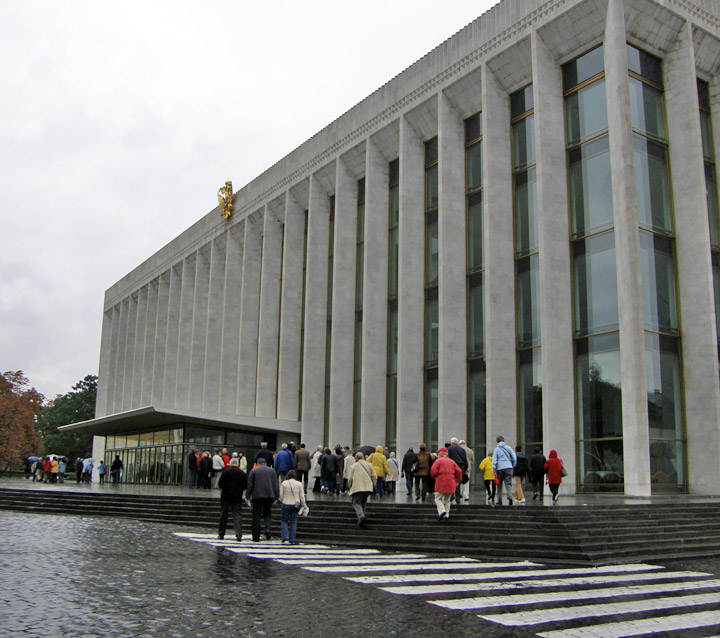
Kremlin Palace of Congresses
Until the 14th century, the site was known as the grad of Moscow. The word "kremlin" was first recorded in 1331 and its etymology is disputed. The "grad" was greatly extended by Prince Yuri Dolgoruky in 1156, destroyed by the Mongols in 1237 and rebuilt in oak in 1339.
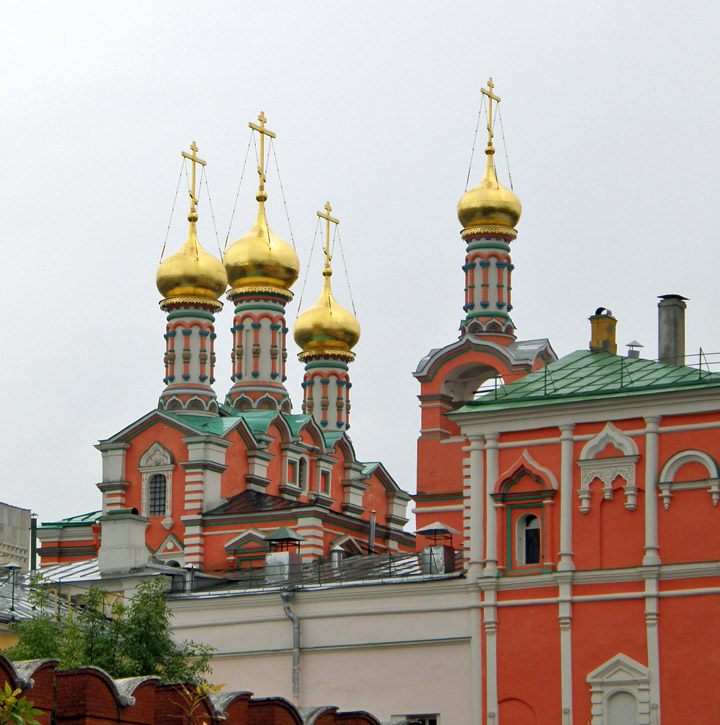
Poteshny Palace
The first recorded stone structures in the Kremlin were built at the behest of Ivan Kalita in the late 1320s and early 1330s, after Peter, Metropolitan of Rus had moved his seat from Kiev to Moscow. The new ecclesiastical capital needed permanent churches. These included the Dormition Cathedral (1327, with St. Peter's Chapel, 1329), the church-belltower of St. John Climacus (1329), the monastery church of the Saviour's Transfiguration (1330), and the Archangel Cathedral (1333) — all built of limestone and decorated with elaborate carving, each crowned by a single dome. Of these churches, the reconstructed Saviour Cathedral alone survived into the 20th century, only to be pulled down at the urging of Stalin in 1933.
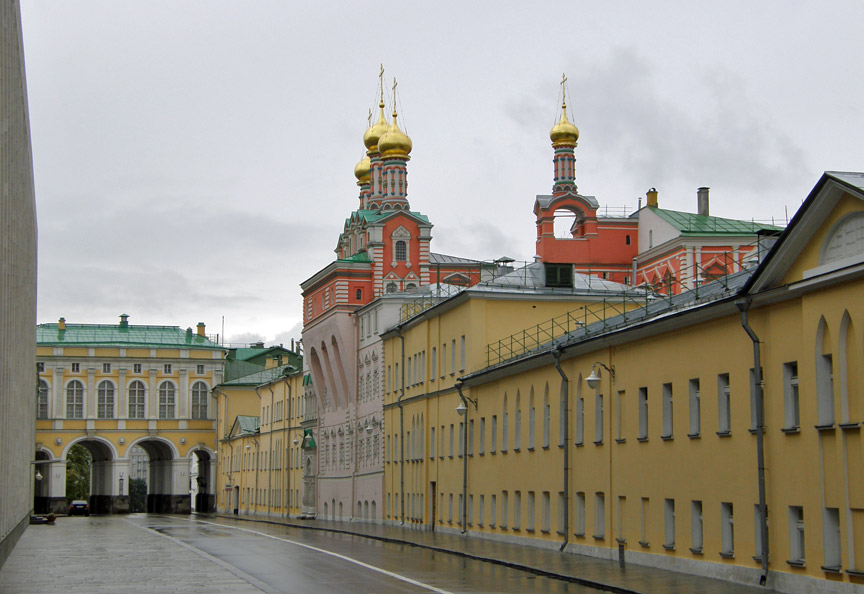
Poteshny Palace
When Dmitri Donskoi prepared to challenge the Tatar authority, he replaced the oaken walls with a strong citadel of white stone (1366-1368), which withstood a siege by Khan Tokhtamysh. Dmitri's son Vasily I made peace with the Tatars and resumed construction of churches and cloisters. The newly-built Annunciation Cathedral was painted by Theophanes the Greek, Andrey Rublev, and Prokhor in 1405. The Chudov Monastery was founded by Dmitri's tutor, Metropolitan Alexis; while his widow, Eudoxia, established the Ascension Convent in 1397.
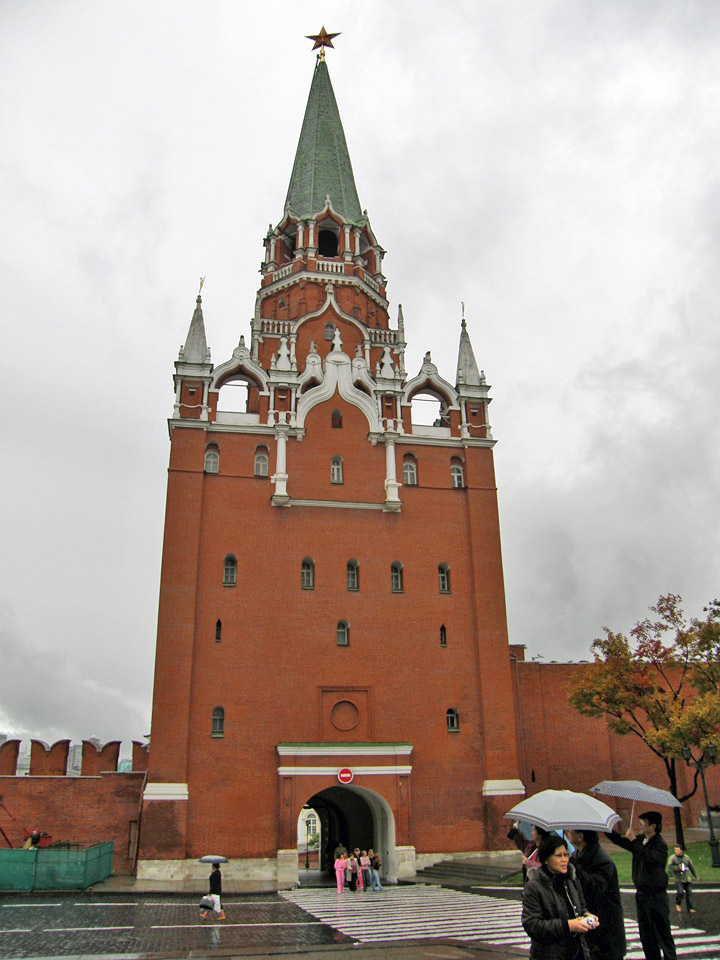
Trinity Gate
as seen from inside the Kremlin walls
By 1475, the principalities of medieval Russia were united under Grand Prince Ivan III, who assumed the title of the Grand Prince of All Rus, envisioning Moscow as the only legitimate successor to Rome and Constantinople. In order to illustrate his imperial ambitions, Ivan organized the reconstruction of the Kremlin, inviting a number of skilled architects from Renaissance Italy, like Pietro Antonio Solari and Marco Ruffo. It was during his reign that three extant cathedrals of the Kremlin, the Deposition Church, and the Palace of Facets were constructed. The highest building of the city and Muscovite Russia was the Ivan the Great Bell Tower, built in 1505-08 and augmented to its present height in 1600.

Arsenal
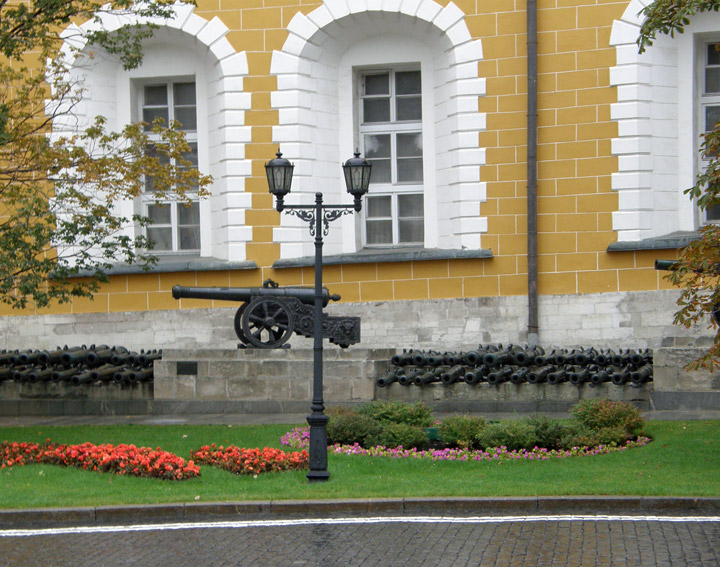
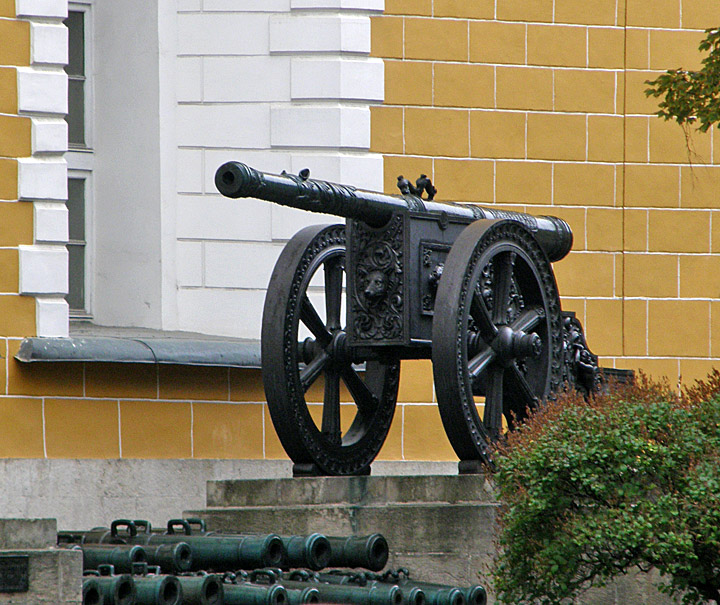
After construction of the new Kremlin walls and churches was over in 1516, the
monarch decreed that no structures should be built in the immediate vicinity of
the citadel. Furthermore, the Kremlin was separated from the walled merchant
town (Kitai-gorod) by a 30-metre-wide moat, over which the Intercession
Cathedral on the Moat was constructed during the reign of Ivan the Terrible. The
same tsar also renovated some of his grandfather's palaces, added a new palace
and cathedral for his sons, and endowed the Trinity metochion inside the
Kremlin. The metochion was administrated by the Trinity Monastery and boasted
the graceful tower church of St. Sergius, which was described by foreigners as
one of the finest in the country.
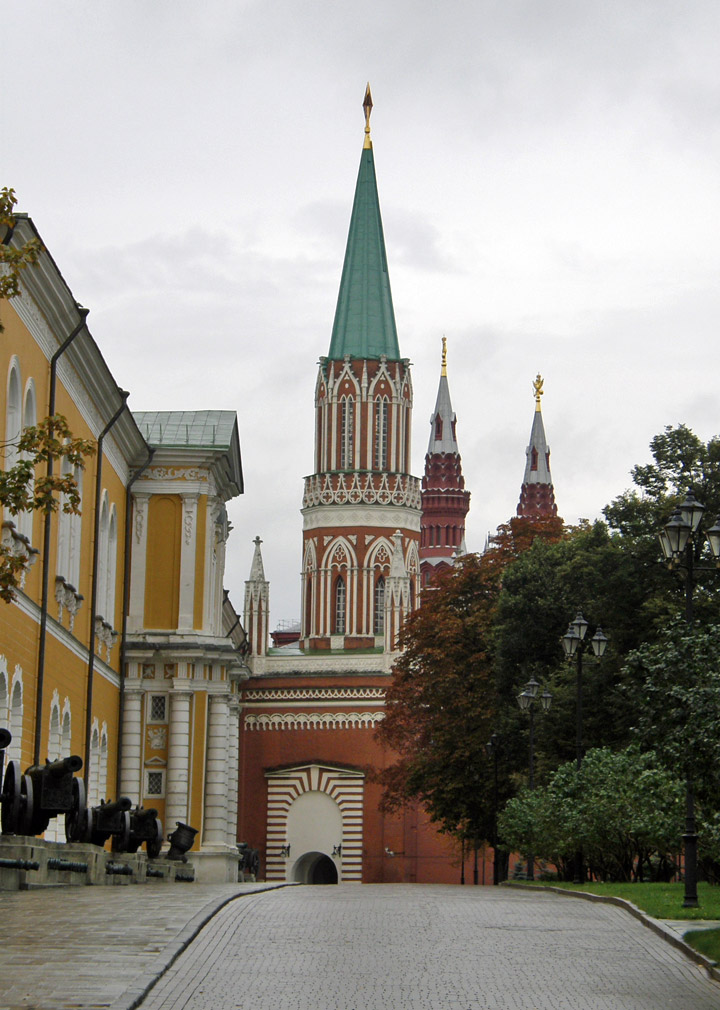
gate leading to red square
During the Time of Troubles, the Kremlin was held by the Polish-Lithuanian
forces for two years, between 21 September 1610 and 26 October 1612. The
Kremlin's liberation by the volunteer army of Kuzma Minin and Dmitry Pozharsky
paved the way for the election of Mikhail Romanov as the new tsar. During his
reign and that of his son Alexis, the eleven-domed Upper Saviour Cathedral,
Armorial Gate, Terem Palace, Amusement Palace and the palace of Patriarch Nikon
were built. Following the death of Alexis, the Kremlin witnessed the Moscow
Uprising of 1682, from which tsar Peter barely escaped alive. This emotional
trauma made him dislike the Kremlin. Three decades later, Peter abandoned the
residence of his forefathers for his new capital, Saint Petersburg.
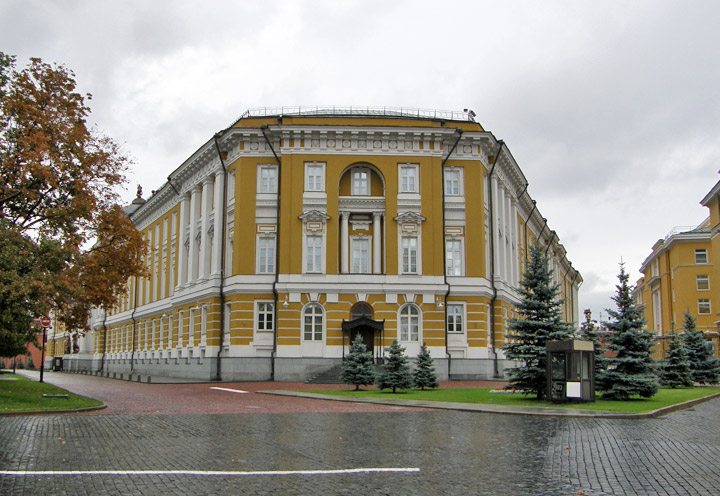
Senate
Although still used for coronation ceremonies, the Kremlin was abandoned and neglected until 1773, when Catherine the Great engaged Vasily Bazhenov to build her new residence there. Bazhenov produced a bombastic Neoclassical design on a heroic scale, which involved the demolition of several churches and palaces, as well as a portion of the Kremlin wall. After the preparations were over, construction halted due to lack of funds. Several years later, Matvei Kazakov restored the dismantled sections of the wall, rebuilt the ancient Saviour Cathedral and some structures of the Chudov Monastery, and constructed the spacious and luxurious residence of the Senate, since adapted for use as the principal workplace of the President of Russia.
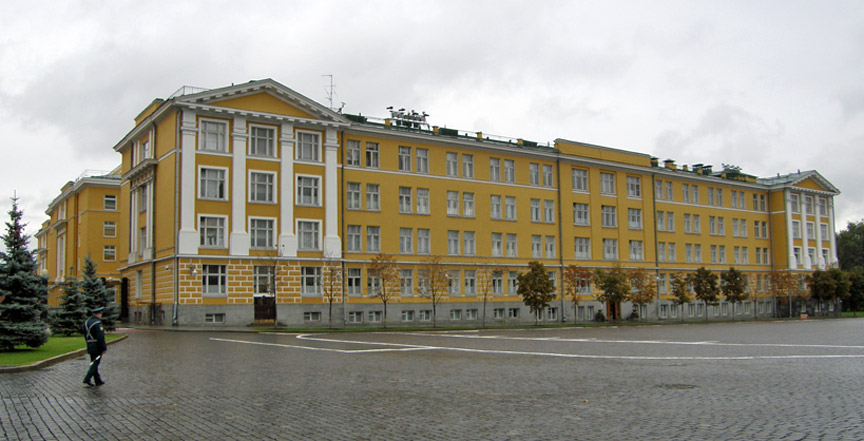
Supreme Soviet
now the quarters of the President of Russia
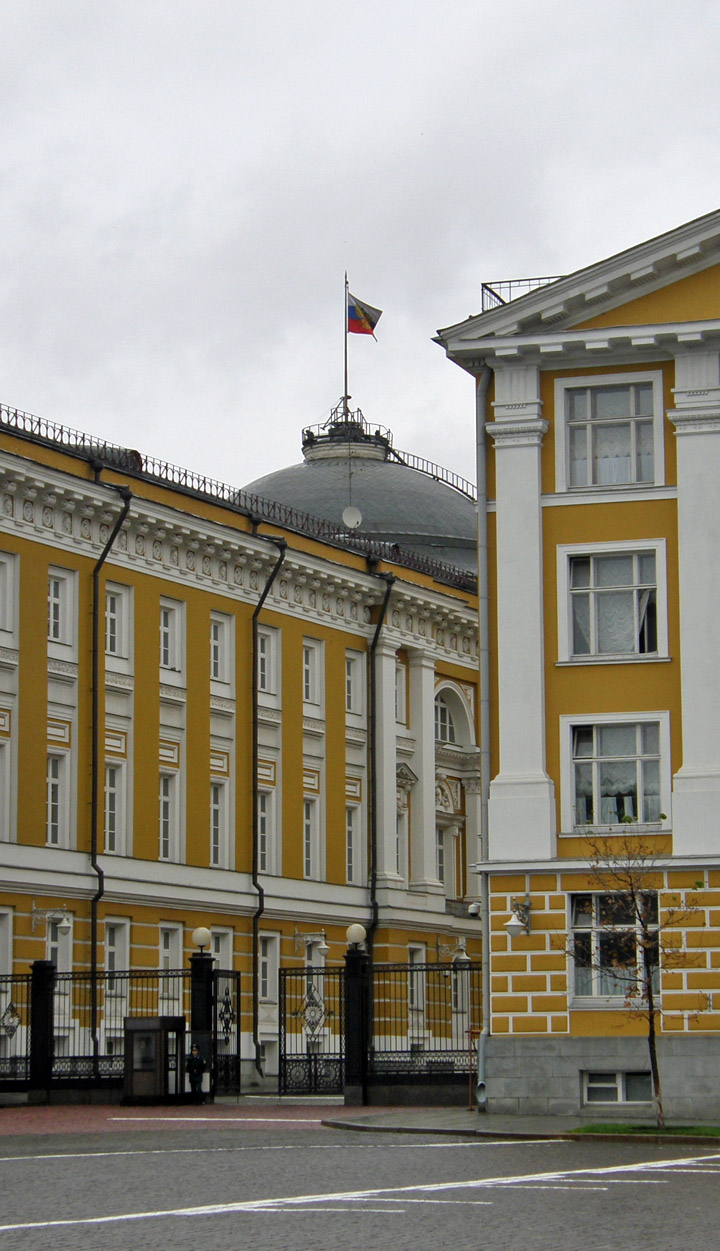
President's Office is under the flag
During Napoleon's invasion of Russia in 1812, the French forces occupied the Kremlin from 2 September to 11 October. When Napoleon fled Moscow, he ordered the whole Kremlin to be blown up. The Kremlin Arsenal, several portions of the Kremlin Wall and several wall towers were destroyed by explosions and fires damaged the Faceted Chamber and churches. Explosions continued for three days, from 21 to 23 October. Fortunately, the rain damaged the fuses, and the damage was less severe than intended. Restoration works were held in 1816-19, supervised by Osip Bove. During the remainder of Alexander I's reign, several ancient structures were overhauled in a fanciful neo-Gothic style, but many more were simply swept away as "disused" or "dilapidated" (including all the buildings of the Trinity metochion).
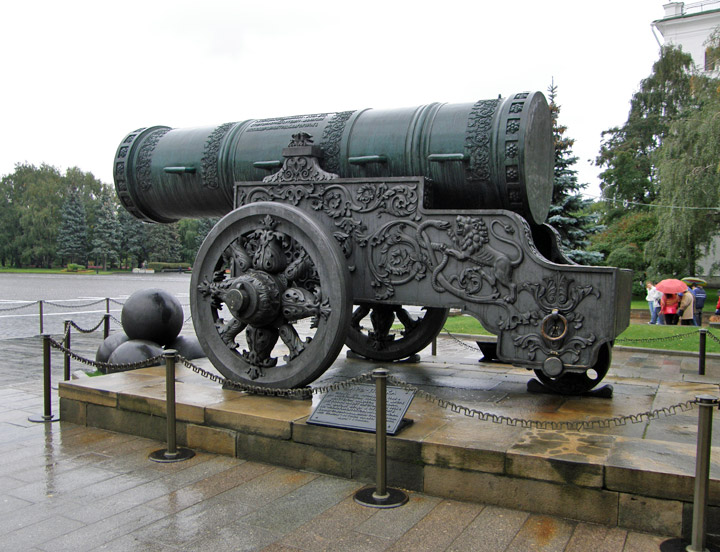
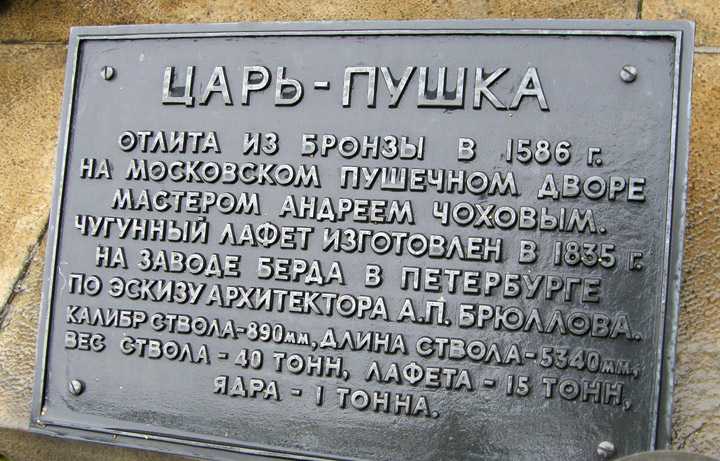
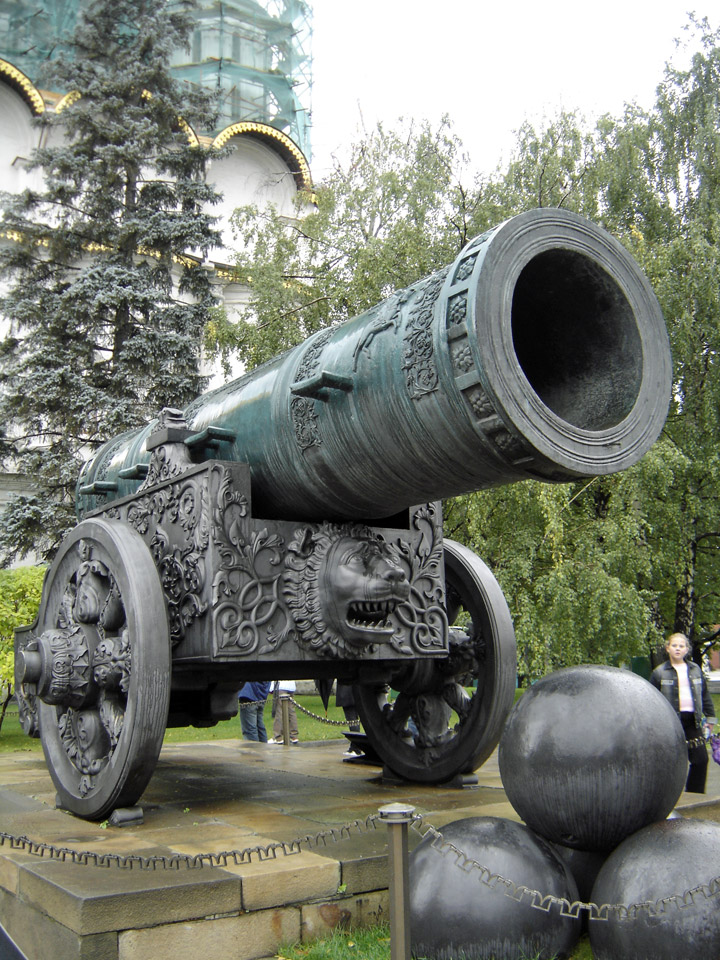
Tsar Cannon
On visiting Moscow during his coronation, Nicholas I of Russia was not satisfied with the Grand, or Winter, Palace, which had been erected to Rastrelli's design in the 1750s. The elaborate Baroque structure was demolished, as of St. John the Precursor, built by Aloisio the New in 1508 in place of the very first church ever constructed in Moscow. The architect Konstantin Thon was commissioned to replace them with the Grand Kremlin Palace, which was to rival the Winter Palace in St. Petersburg by its dimensions and the opulence of its interiors. The palace was constructed in 1839-49, followed by the new building of the Kremlin Armory in 1851.

Tsar Bell
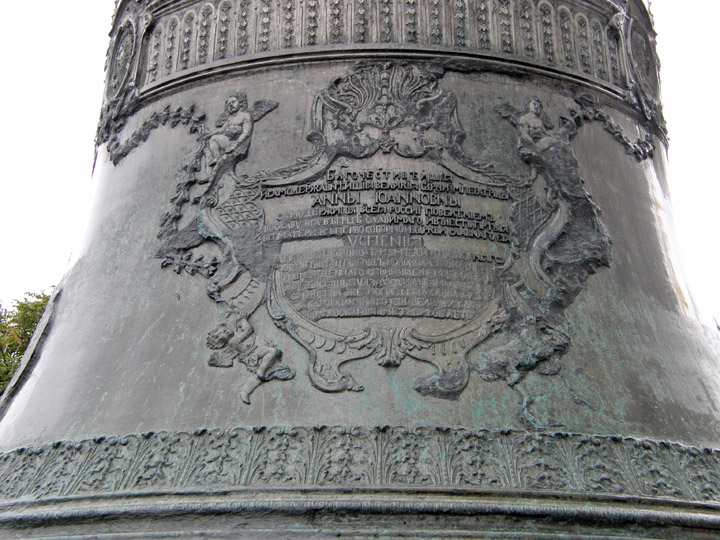
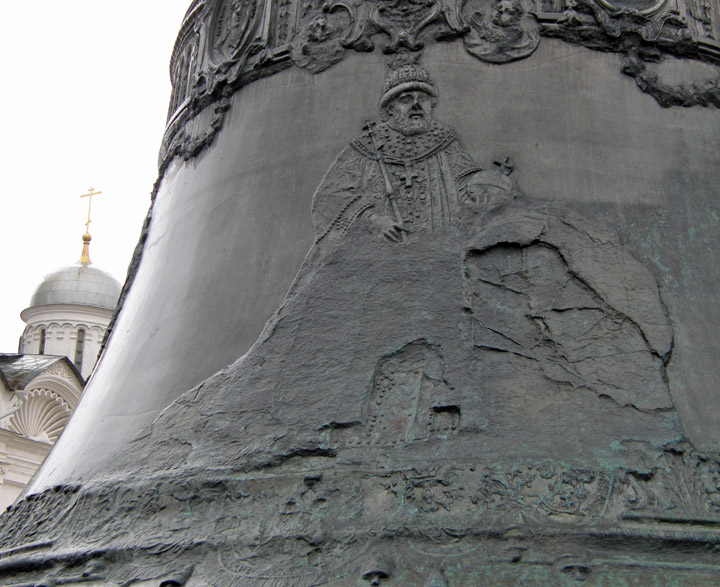
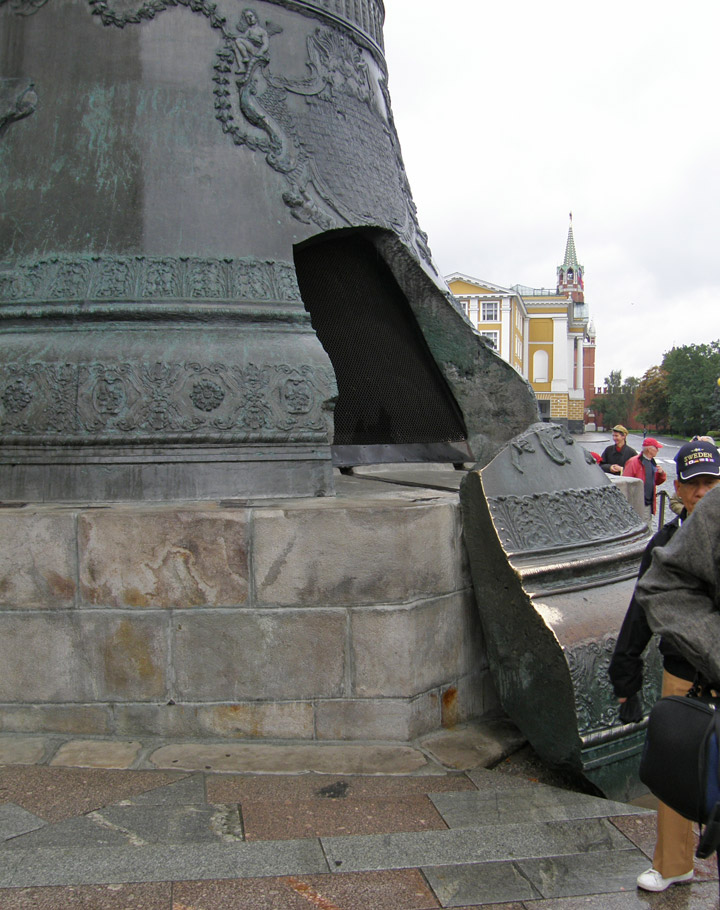
like the U.S. Liberty Bell, it cracked
After that, there was virtually no new construction in the Kremlin until the Russian Revolution of 1917. The only new structures were the Monument to Alexander II and a stone cross marking the spot where Grand Duke Sergey Aleksandrovich of Russia was assassinated by Ivan Kalyayev in 1905. These monuments were destroyed by the Bolsheviks in 1918.
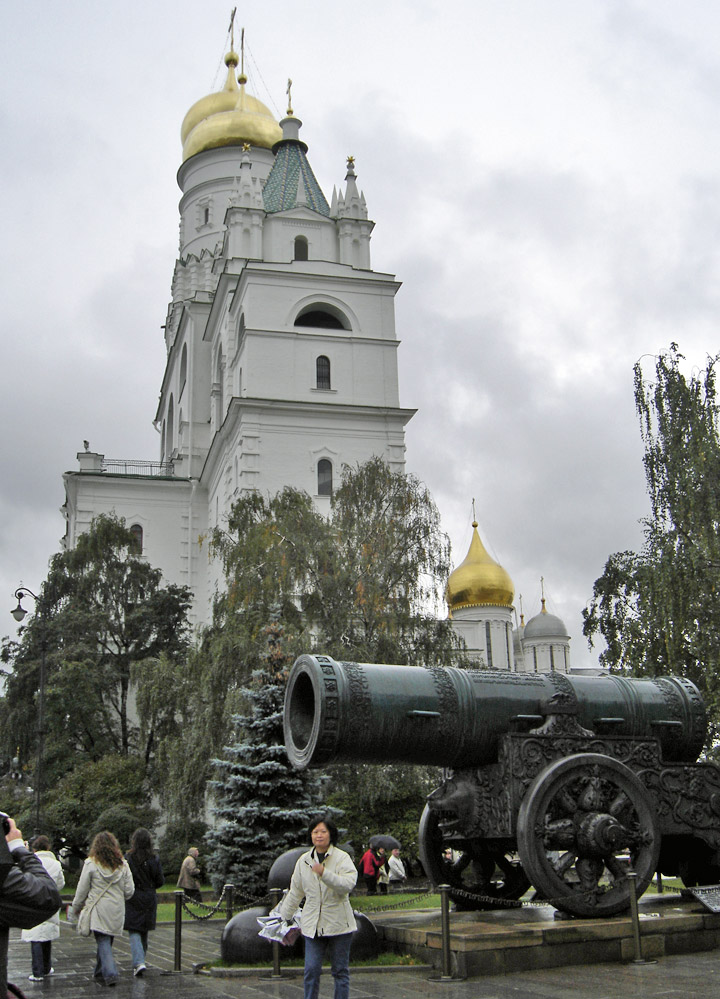
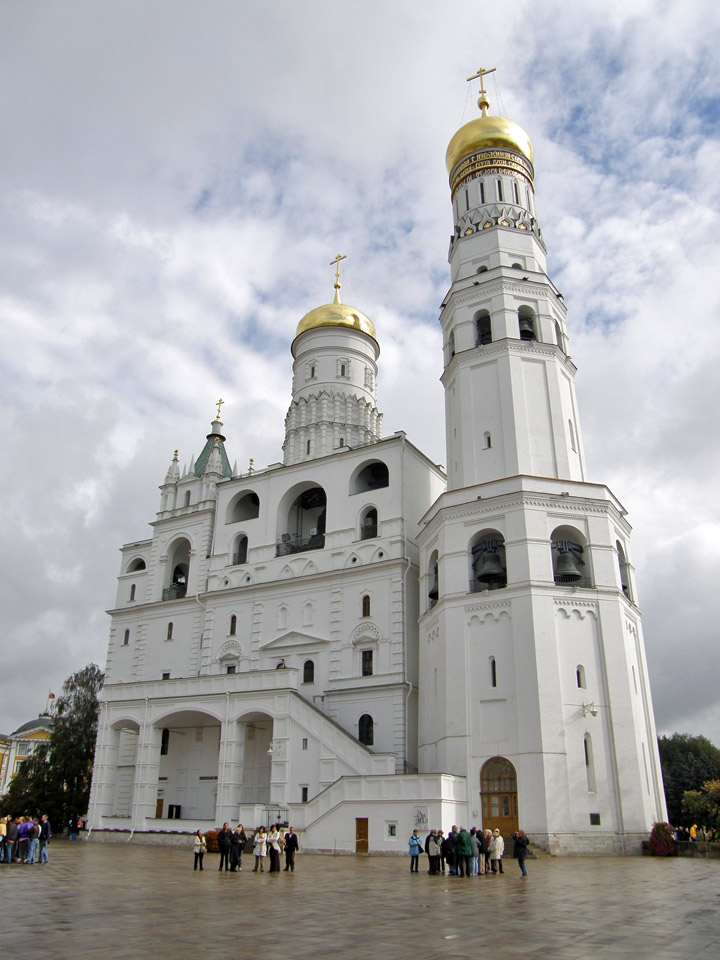
Ivan the Great Bell Tower
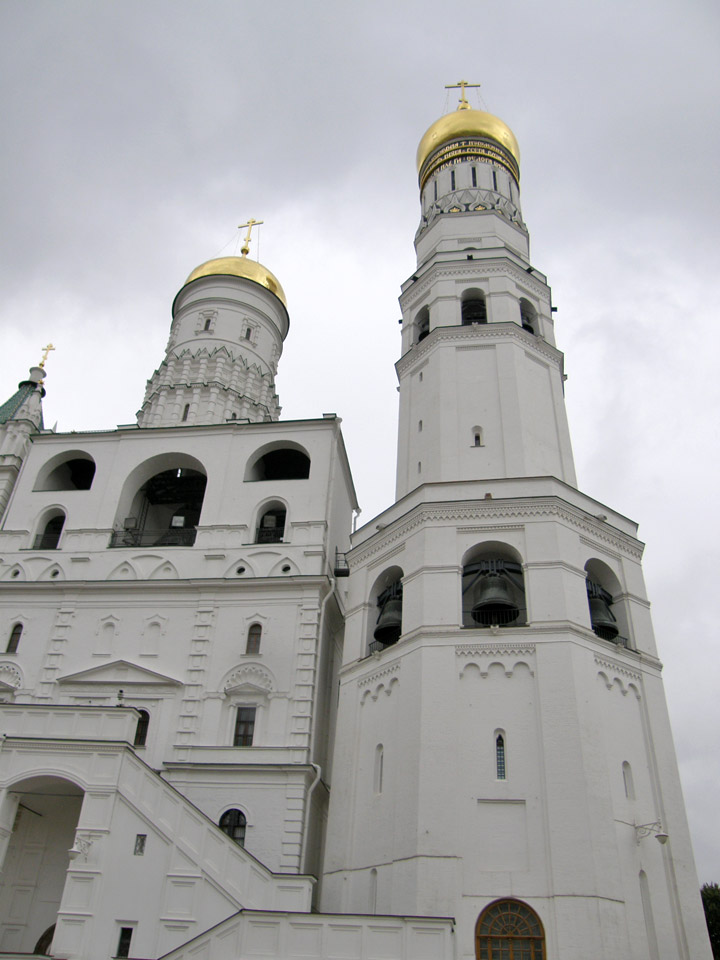
Ivan the Great Bell Tower
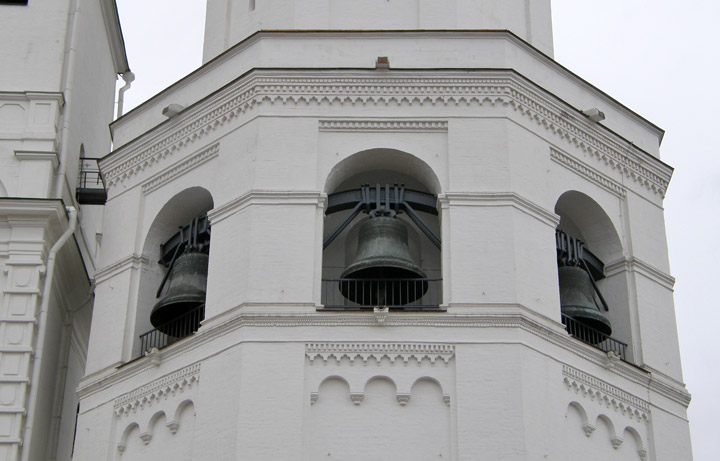
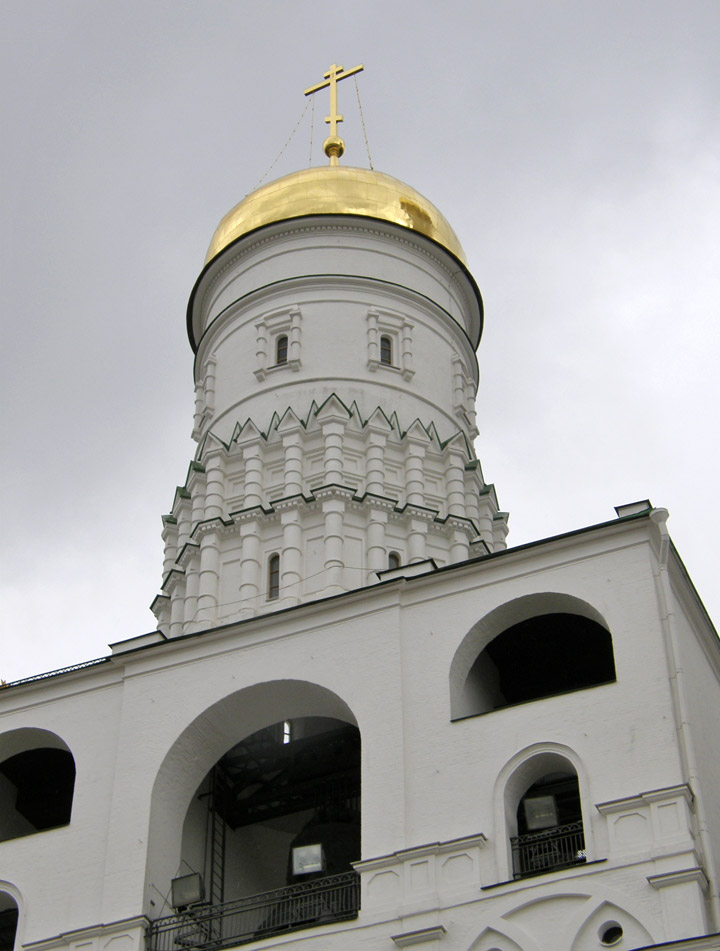
The Soviet government fled from Petrograd to Moscow on 12 March 1918. Lenin
selected the Kremlin Senate as his residence; his room is still preserved as a
museum. Stalin also had his personal rooms in the Kremlin. He was eager to
remove from his headquarters all the "relics of the tsarist regime". Golden
eagles on the towers were replaced by shining Kremlin stars, while the wall near
Lenin's Mausoleum was turned into the Kremlin Wall Necropolis.
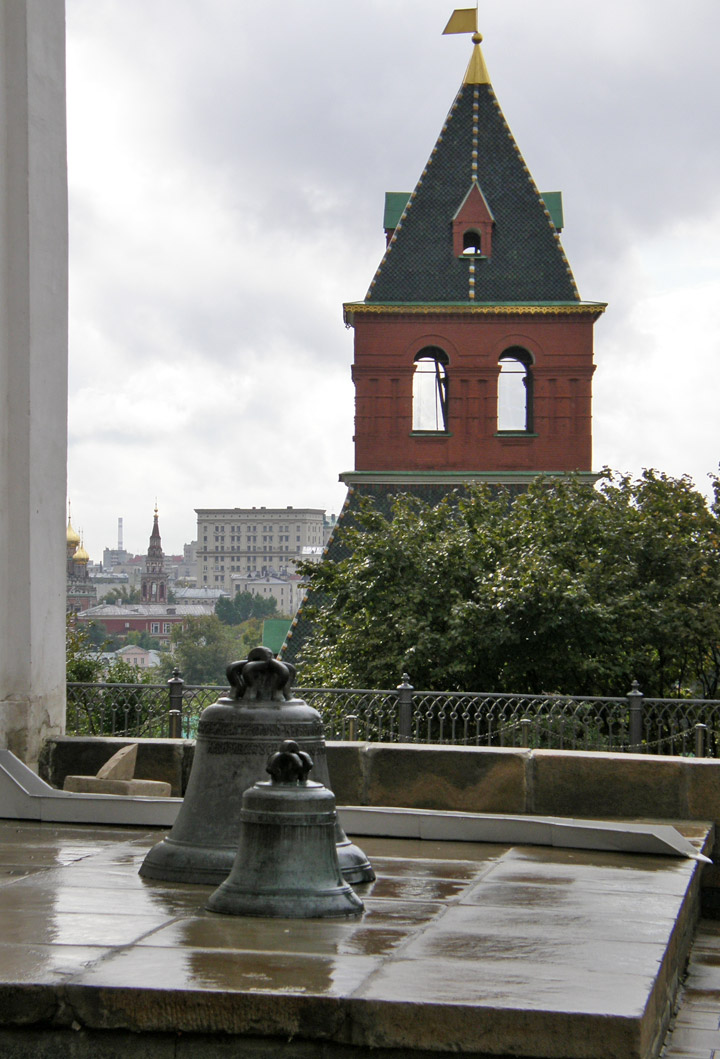
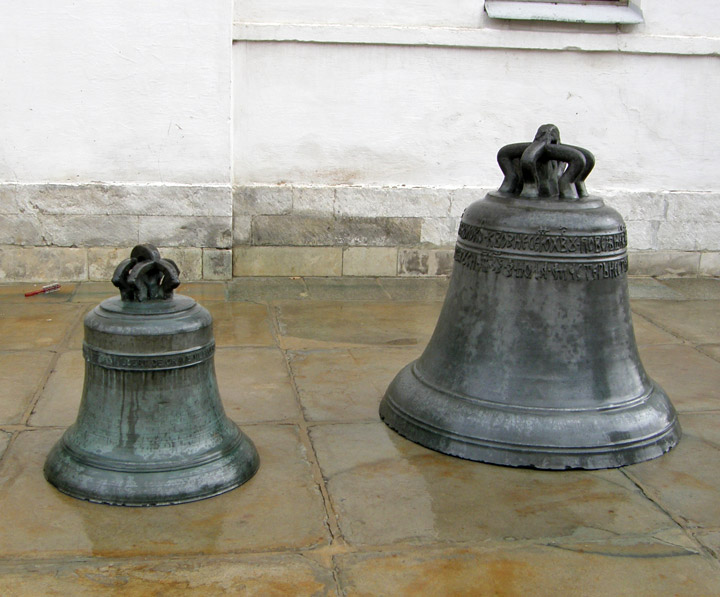
smaller bells
The Chudov Monastery and Ascension Convent, with their magnificent 16th-century
cathedrals, were dismantled to make room for the Communist military school and
Palace of Congresses. The Little Nicholas Palace and the old Saviour Cathedral
were pulled down as well. The residence of the Soviet government was closed to
tourists until 1955. It was not until the Khrushchev Thaw that the Kremlin was
reopened to foreign visitors. The Kremlin Museums were established in 1961 and
the complex was among the first Soviet patrimonies inscribed on the World
Heritage List in 1990.

Ivan III's Palace of Facets (1491)
Although the current director of the Kremlin Museums, Elena Gagarina (Yuri Gagarin's daughter) advocates a full-scale restoration of the destroyed cloisters, recent developments have been confined to expensive restoration of the original interiors of the Grand Kremlin Palace, which were altered during Stalin's rule. The Patriarch of Moscow has a suite of rooms in the Kremlin, but divine service in the Kremlin cathedrals is held irregularly, because they are still administrated as museums.
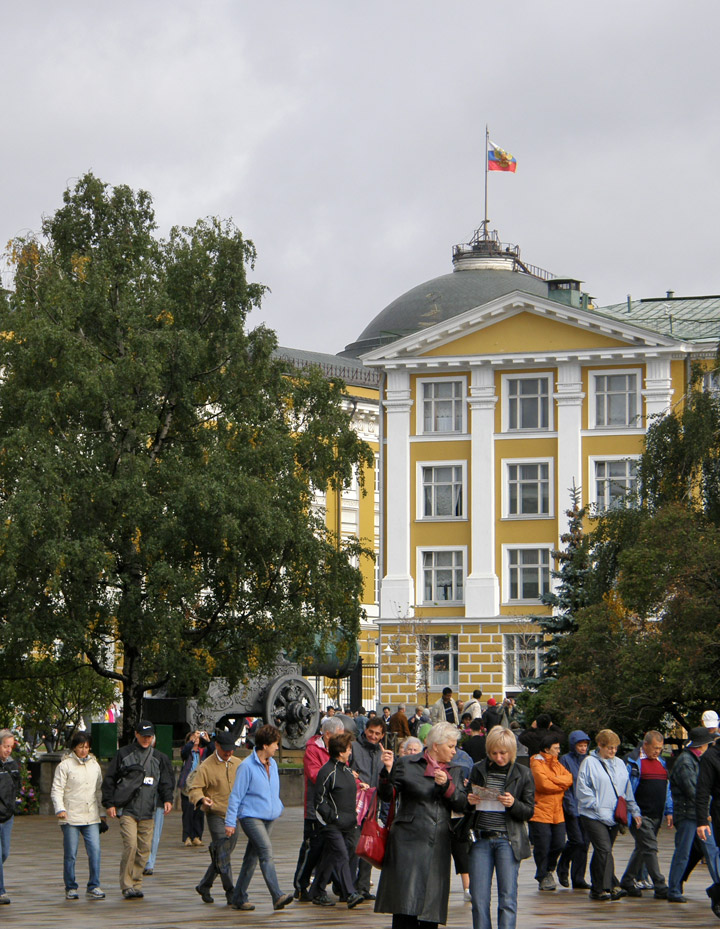
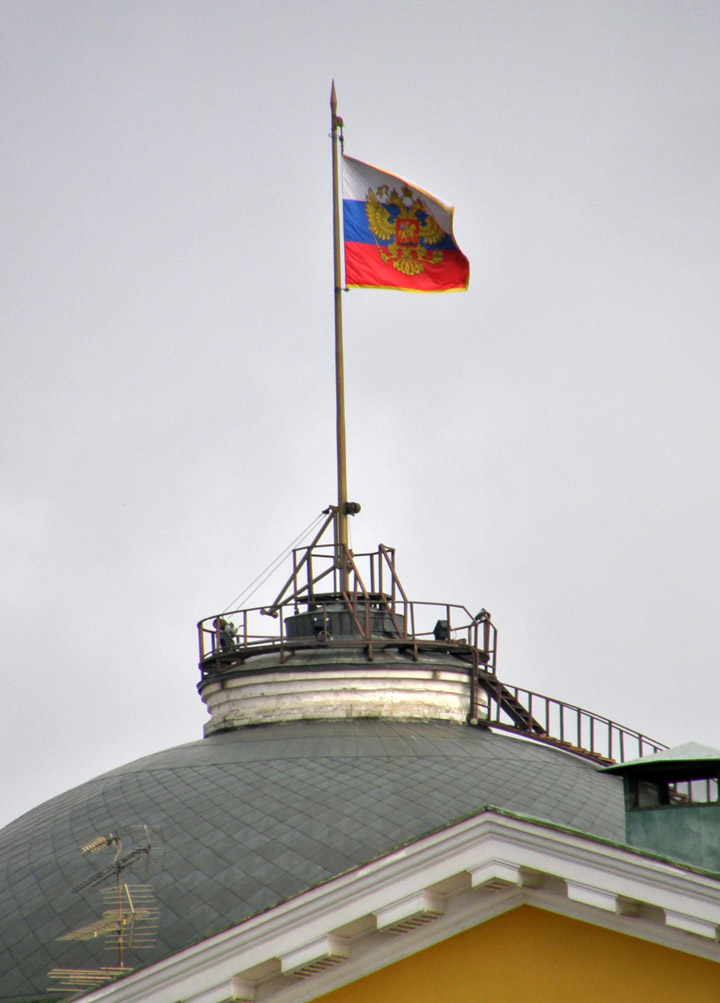
The Existing Kremlin walls and towers were built by Italian masters over the
years 1485 to 1495. The irregular triangle of the Kremlin wall encloses an area
of 275,000 square meters (68 acres). Its overall length is 2235 meters (2444
yards), but the height ranges from 5 to 19 metres, depending on the terrain. The
wall's thickness is between 3.5 and 6.5 meters.
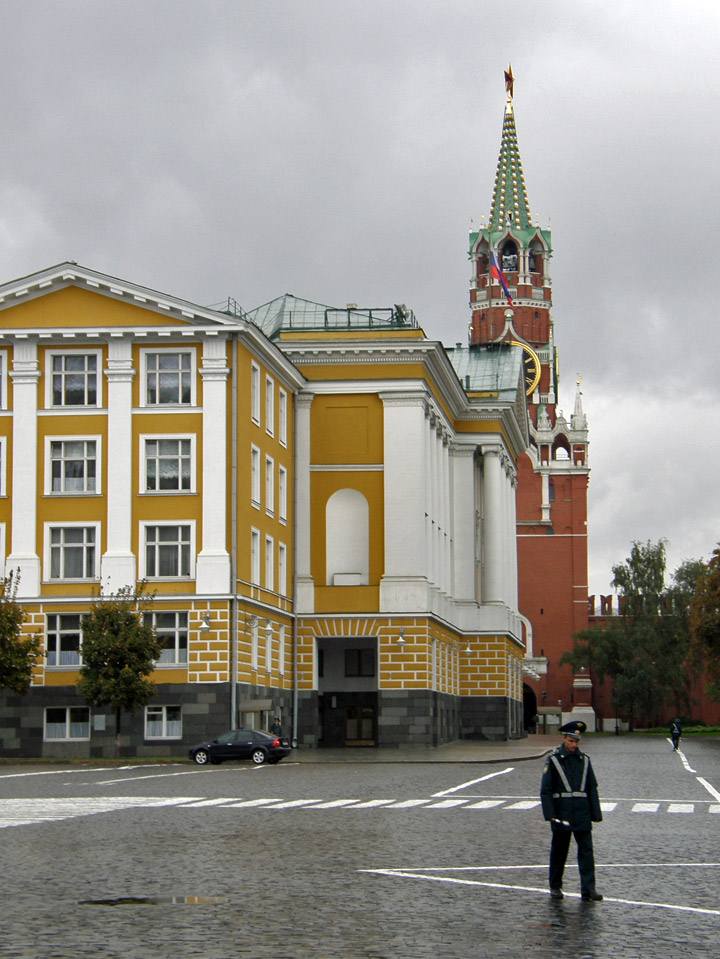
Savior Gate Tower
Originally there were eighteen Kremlin towers, but their number increased to twenty in the 17th century. All but three of the towers are square in plan. The highest tower is the Spasskaya, which was built up to its present height of 71 metres in 1625. Most towers were originally crowned with wooden tents; the extant brick tents with strips of colored tiles go back to the 1680s.
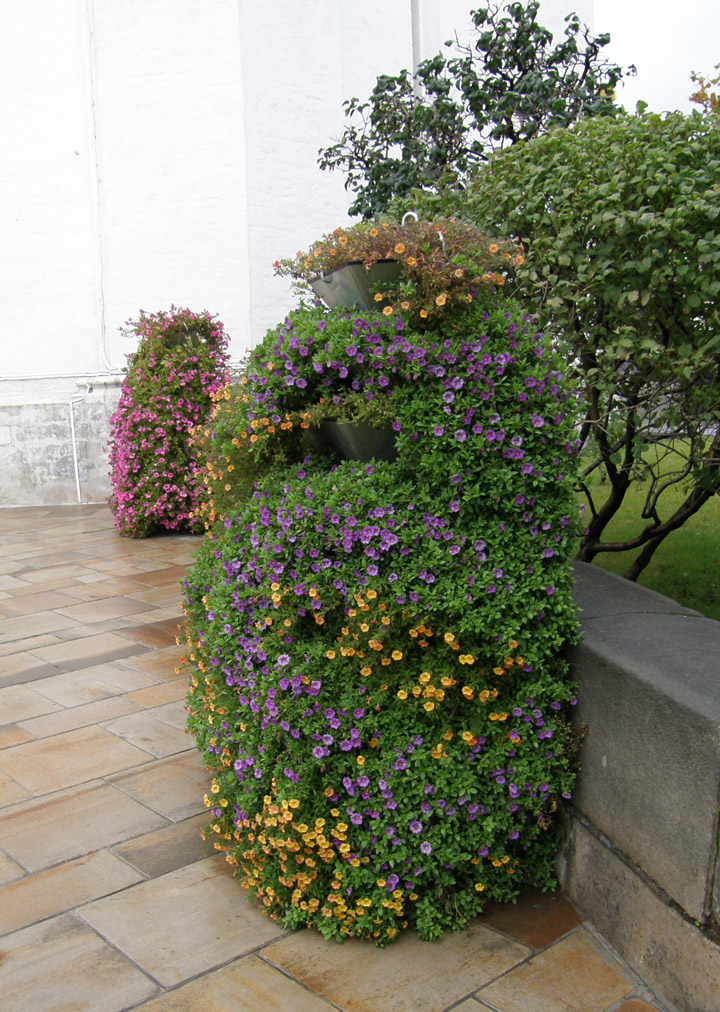
Cathedral Square is the heart of the Kremlin. It is surrounded by six buildings,
including three cathedrals. The Cathedral of the Dormition was completed in 1479
to be the main church of Moscow and where all the Tsars were crowned. The
massive limestone facade, capped with its five golden cupolas was the design of
Aristotele Fioravanti. Several important metropolitans and patriarchs are buried
there, including Peter and Makarii The gilded, three-domed Cathedral of the
Annunciation was completed next in 1489, only to be reconstructed to a
nine-domed design a century later. On the south-east of the square is the much
larger Cathedral of the Archangel Michael (1508), where almost all the Muscovite
monarchs from Ivan Kalita to Alexis I of Russia are interred. (Boris Godunov was
originally buried there, but was moved to the Troitse-Sergiev Monastery.)
Tsarevich Dmitrii, the son of Ivan the Terrible, was buried there in the early
1600s. Emperor Peter II is also buried there, the only post-Petrine monarch
buried in the Kremlin (and the only one besides Ivan VI who is not buried in the
Peter and Paul Cathedral in St. Petersburg.)
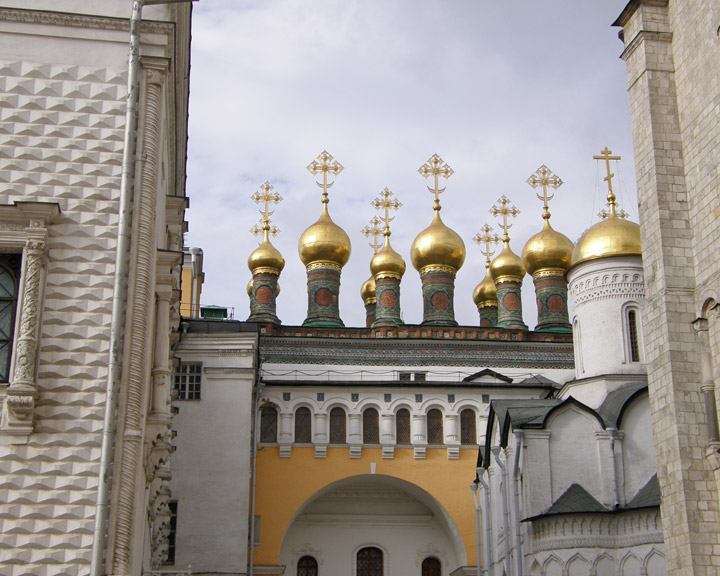
Church of the Twelve Apostles (1654-56).
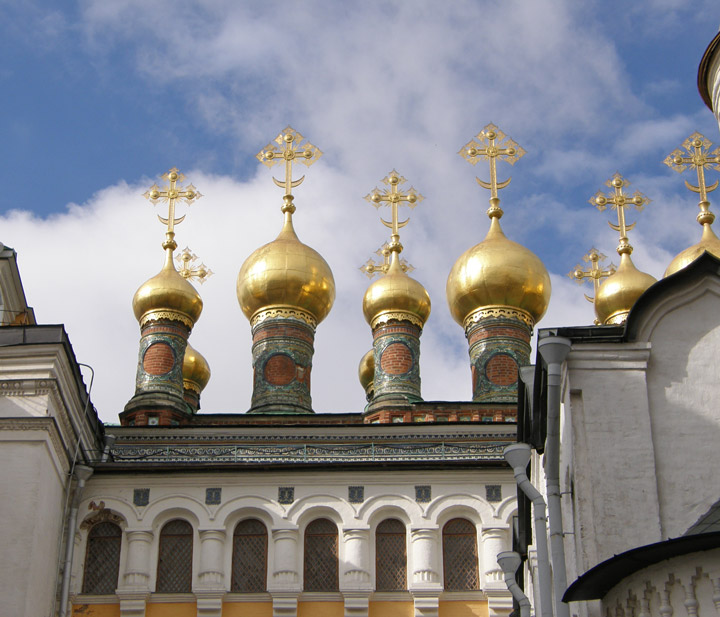

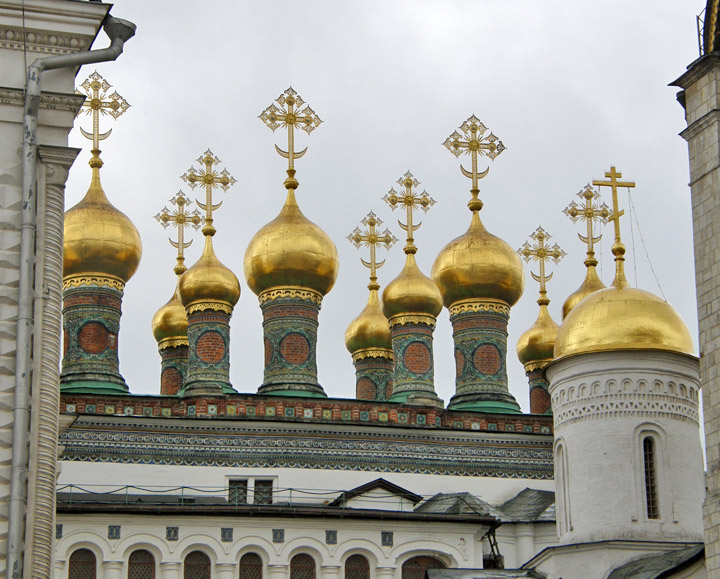
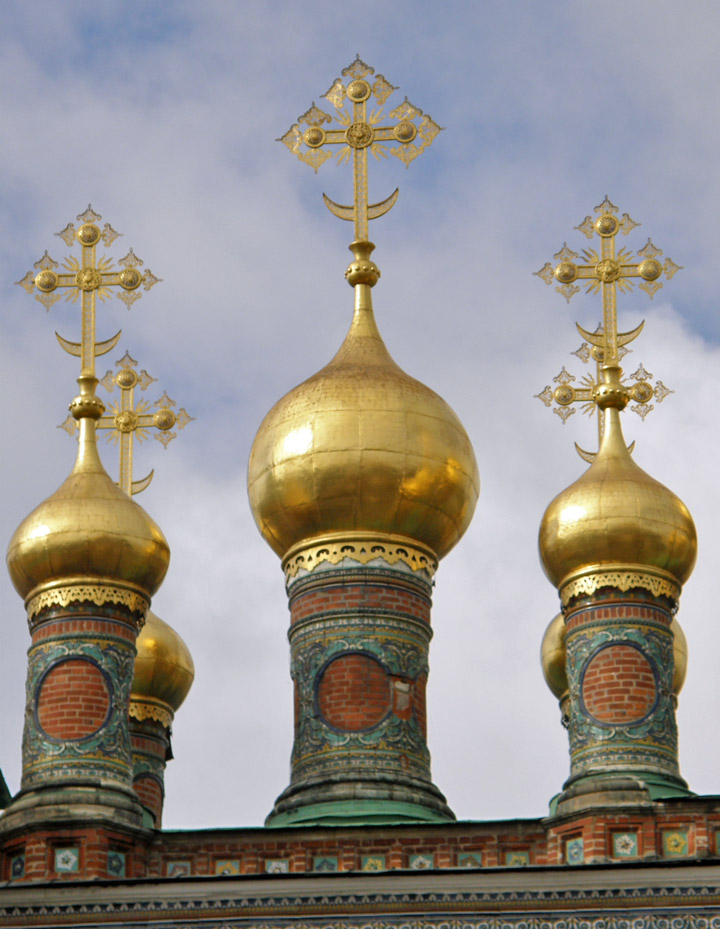
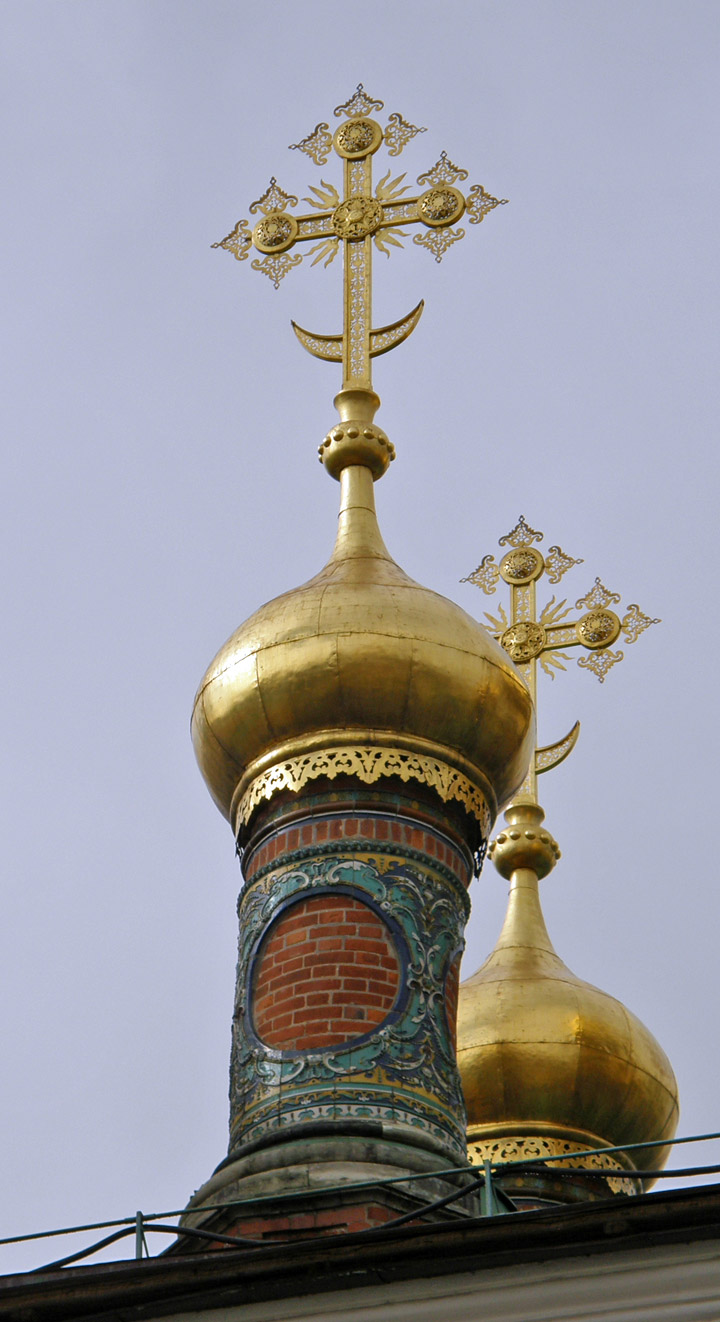
There are two domestic churches of the Metropolitans and Patriarchs of Moscow,
the Cathedral of the Twelve Apostles (1653-56) and the one-domed exquisite
church of the Deposition of the Virgin's Robe, built by Pskov artisans over the
years 1484-88 and featuring superb icons and frescoes from 1627 and 1644.
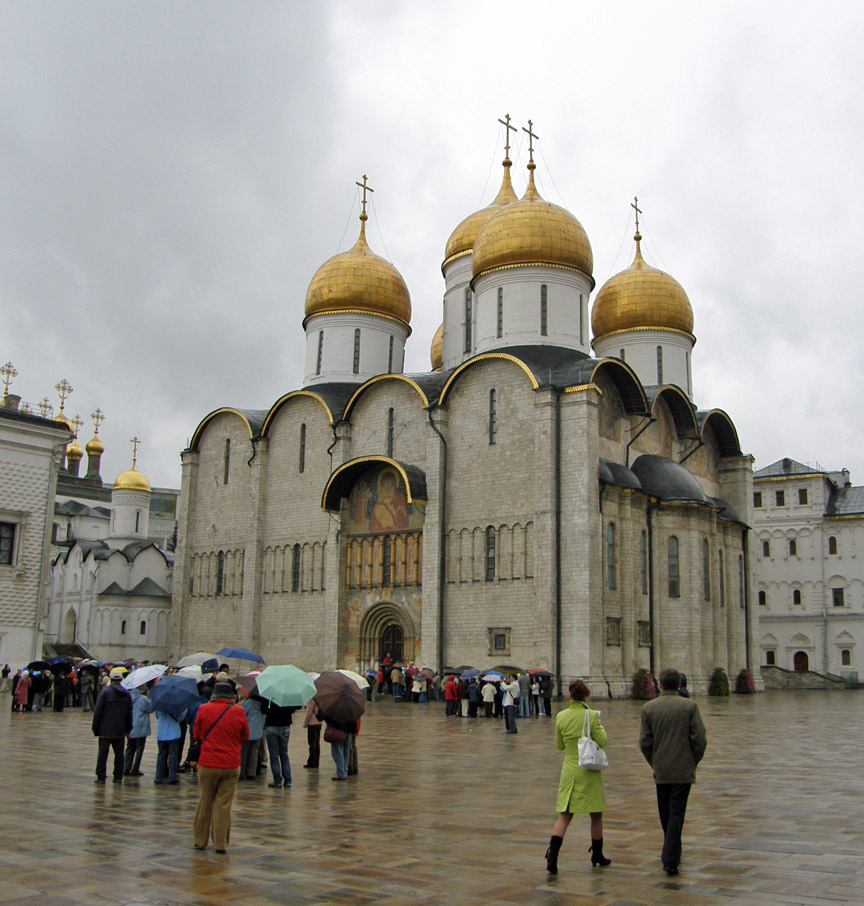
Assumption Cathedral
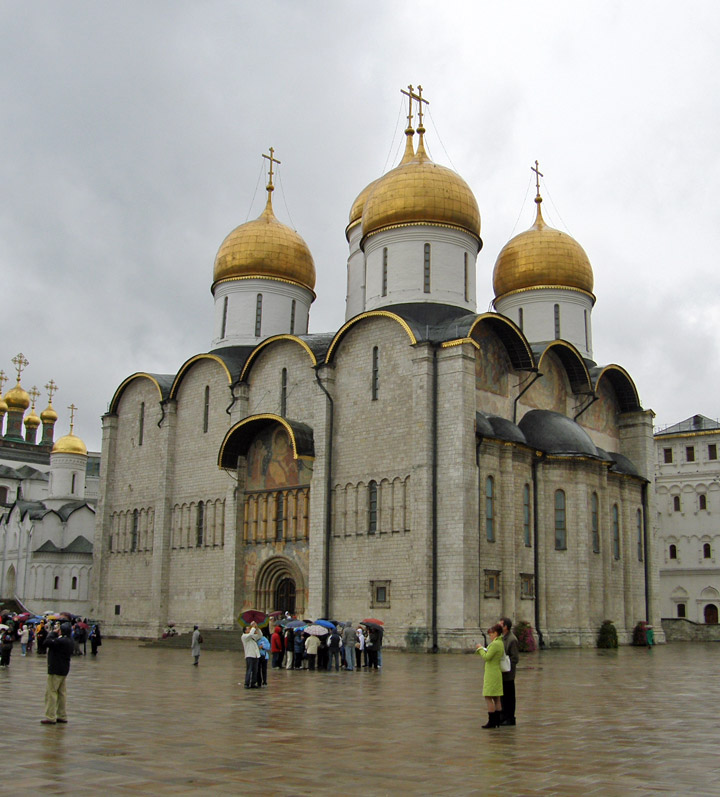

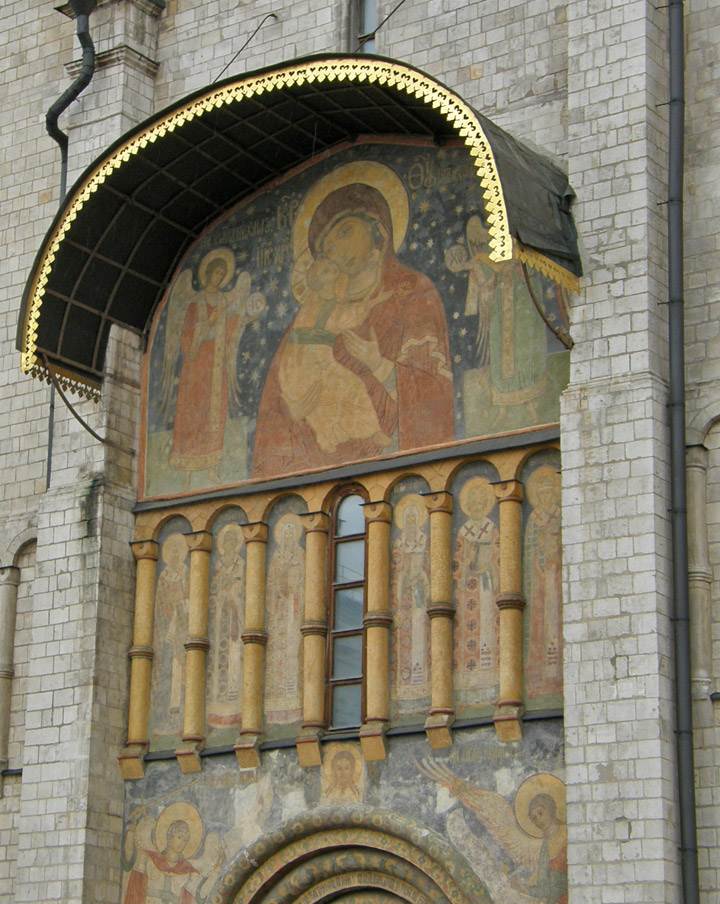
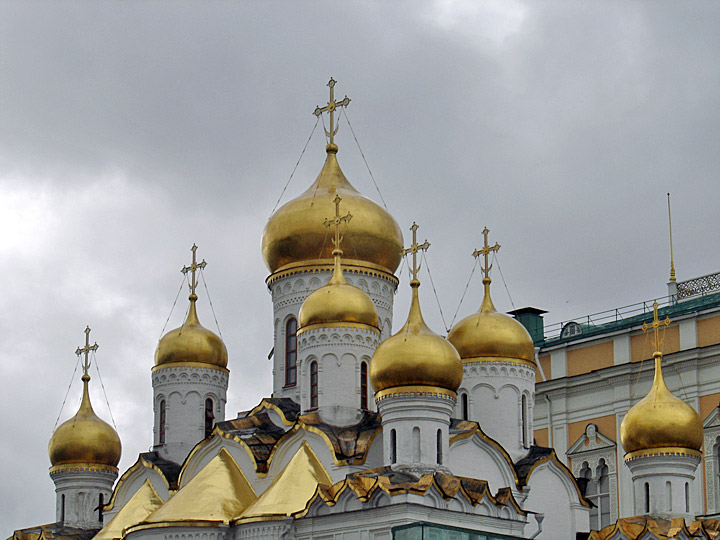
The other notable structure is the Ivan the Great Bell Tower on the north-east
corner of the square, which is said to mark the exact centre of Moscow and
resemble a burning candle. Completed in 1600, it is 81 meters (266 ft) high.
Until the Russian Revolution, it was the tallest structure in the city, as
construction of buildings taller than that was forbidden. Its 21 bells would
sound the alarm if any enemy was approaching. The upper part of the structure
was destroyed by the French during the Napoleonic Invasion and has, of course,
been rebuilt.

Annunciation Cathedral
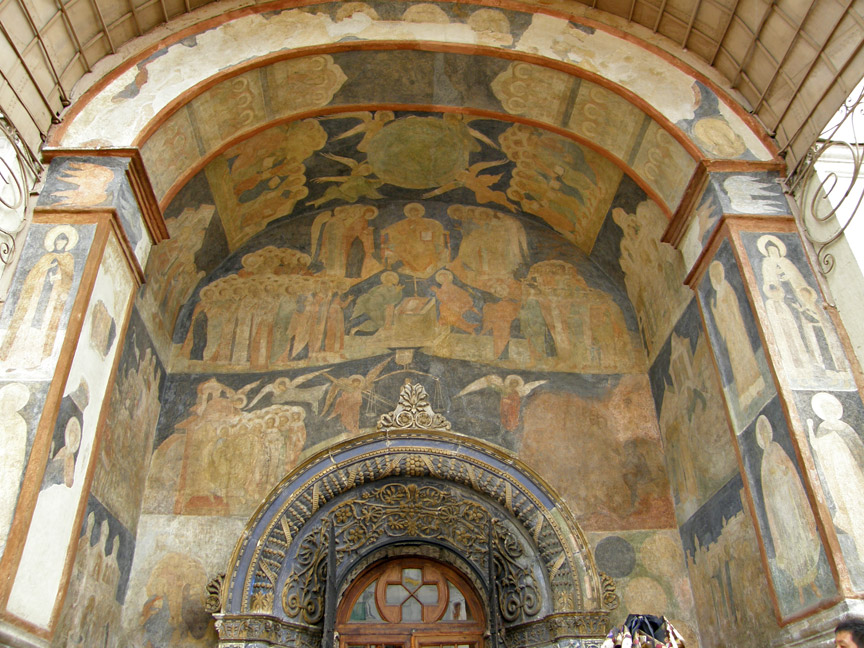
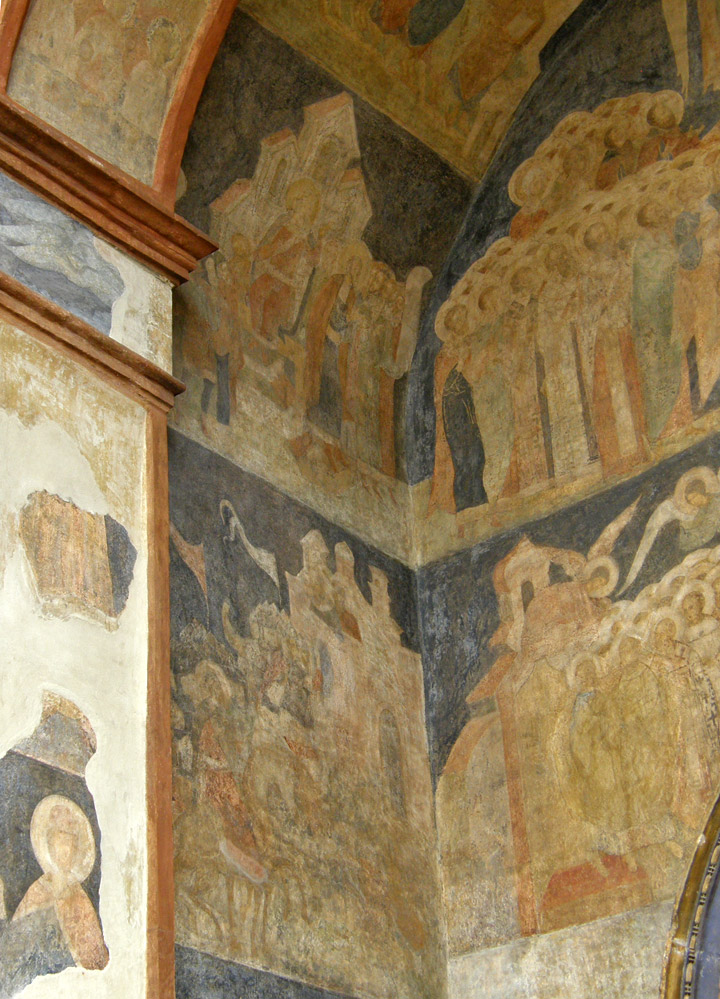
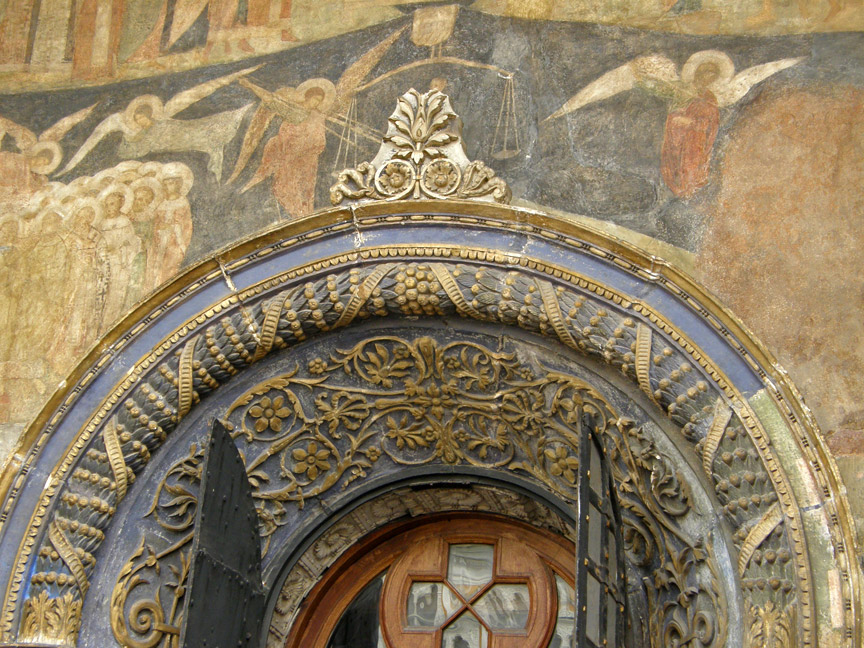
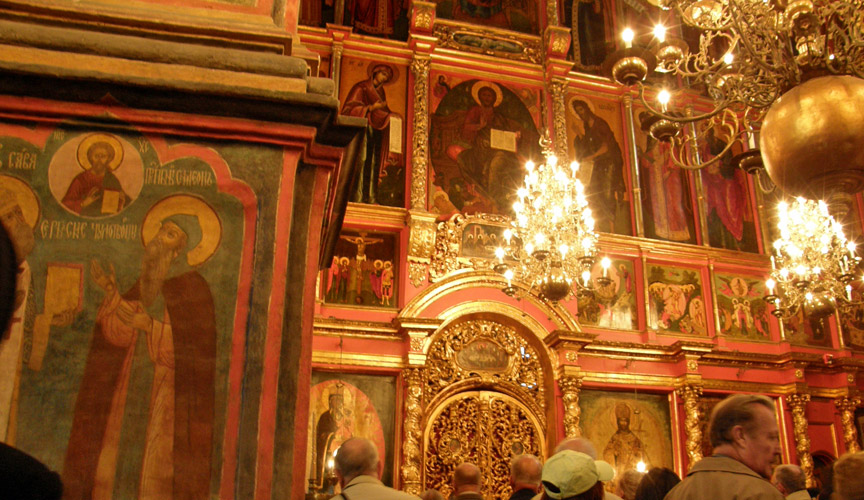

The oldest secular structure still standing is Ivan III's Palace of Facets
(1491), which holds the imperial thrones. The next oldest is the first home of
the royal family, the Terem Palace. The original Terem Palace was also
commissioned by Ivan III, but most of the existing palace was built in the 17th
century. The Terem Palace and the Palace of Facets are linked by the Grand
Kremlin Palace. This was commissioned by Nicholas I in 1838. The largest
structure in the Kremlin, it cost an exorbitant sum of eleven million rubles to
build and more than one billion dollars to renovate in the 1990s. It contains
dazzling reception halls, a ceremonial red staircase, private apartments of the
tsars, and the lower storey of the Resurrection of Lazarus church (1393), which
is the oldest extant structure in the Kremlin and the whole of Moscow.
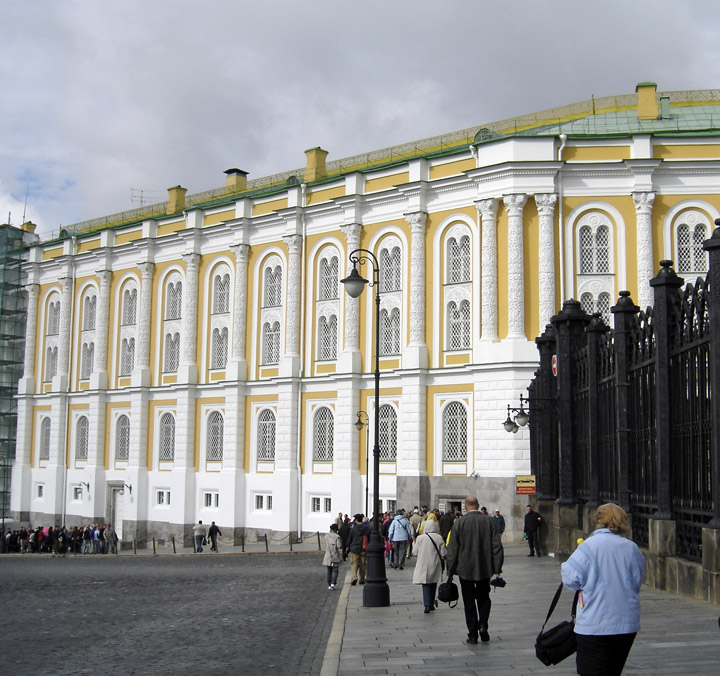
Armory
The northeast corner of the Kremlin is occupied by the Arsenal, which was originally built for Peter the Great in 1701. The northwestern section of the Kremlin holds the Armory building. Built in 1851 to a Renaissance Revival design, it is currently a museum housing Russian state regalia and Diamond fund.
Text from Wikipedia
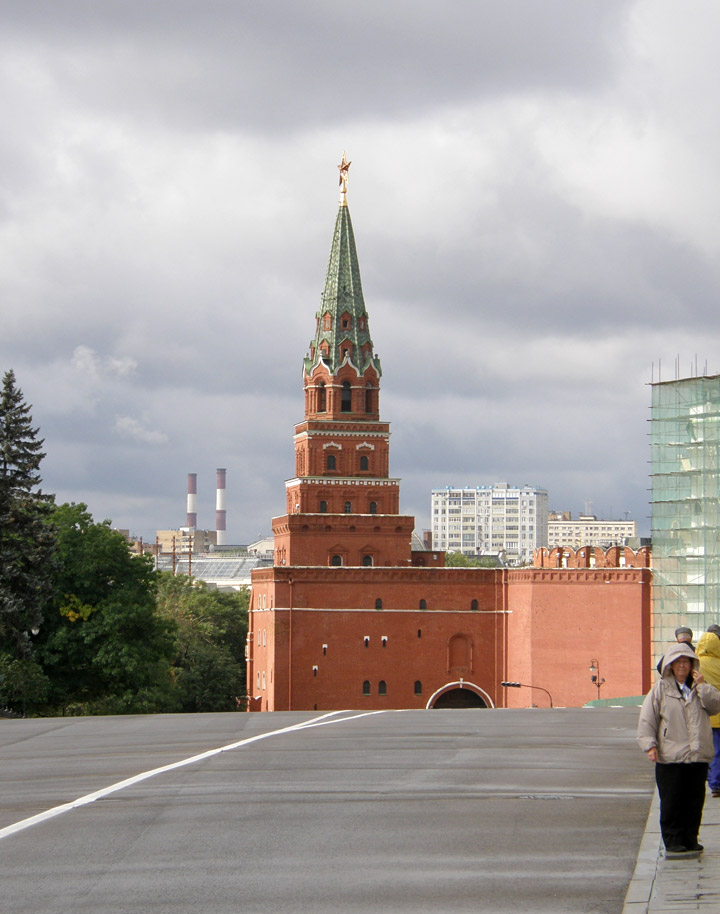
Borovitskaya Gate Tower
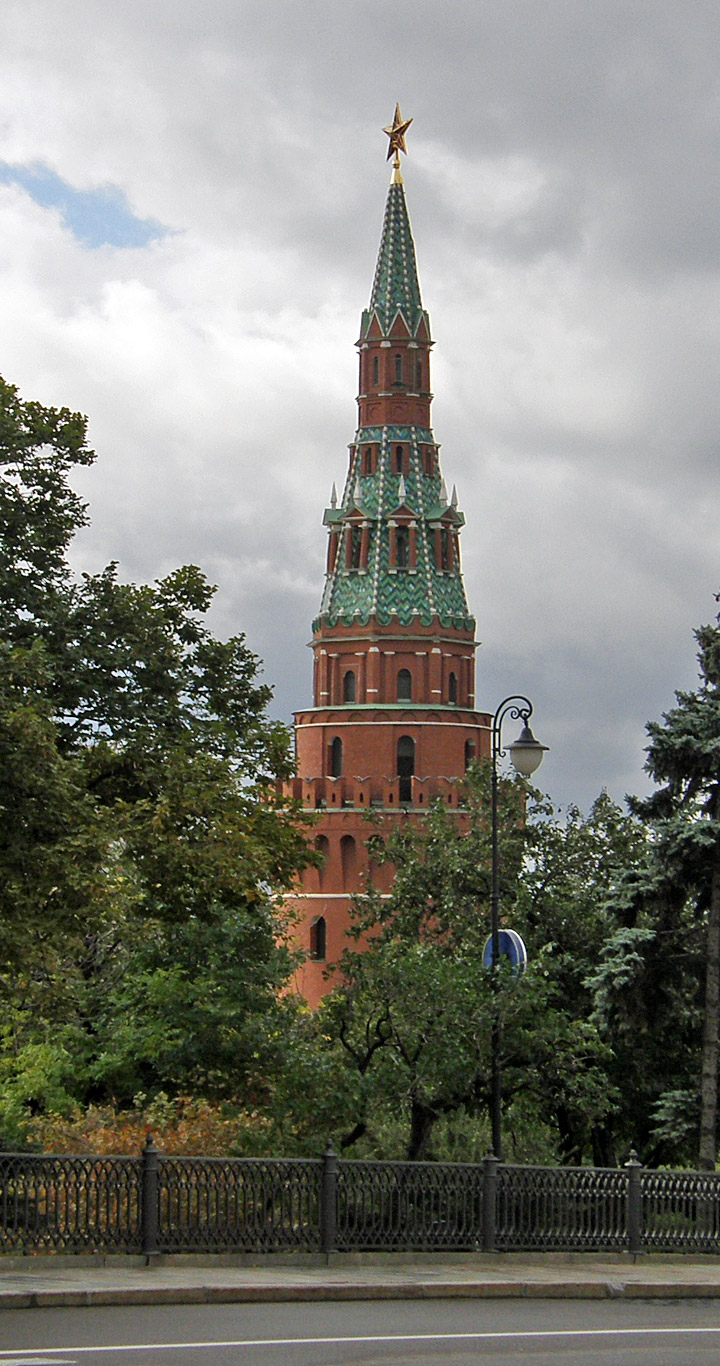
Annunciation Tower